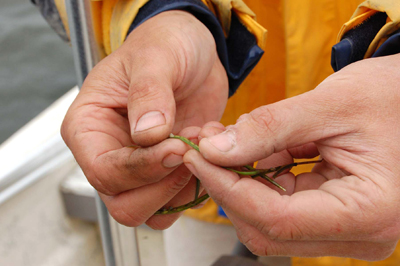Ask a Scientist: Can I help restore bay grasses in my local creek?
Todays question is about restoring bay grasses in the Chesapeake Bay. One of our readers wanted to know if he could help restore bay grass.
Today we’re introducing a new blog feature called “Ask a Scientist.” Each month, we'll take a question submitted through our website or Twitter (@chesbayprogram) and have a scientist from the Bay Program partnership answer it here on our blog.
Today's question is about restoring bay grasses in the Chesapeake Bay. One of our readers wanted to know if he could help restore bay grasses in his local creek by planting bay grass seeds. We turned to Mark Lewandowski, natural resources biologist with the Maryland Department of Natural Resources and member of the Bay Program's Submerged Aquatic Vegetation (SAV) Workgroup, for some expert advice.
 Many people who live in the Chesapeake Bay watershed do everything they can to help the environment. They recycle, compost, use rain barrels, or plant native plants and shrubs. But people always want to know what else they can do.
Many people who live in the Chesapeake Bay watershed do everything they can to help the environment. They recycle, compost, use rain barrels, or plant native plants and shrubs. But people always want to know what else they can do.
Culturing oysters, growing wetland plants and planting underwater bay grasses all seem like good, easy ways to help. So what’s so hard about planting bay grasses? Isn’t it as simple as getting some seeds, planting them in an aquarium and watching them grow?
Many people have successfully grown grasses in their aquarium. But very few people have had success planting them in the Bay because the grasses do not survive over the long term. Selecting an appropriate site to plant bay grasses requires a lot of research and information.
Water quality is the biggest factor in bay grass survival. All bay grasses need enough light to photosynthesize, so clear water is critical. Each type of bay grass has very specific physiological needs that are different for each species.
The next requirement is proper substrate.; The bottom sediment can't be too sandy or the plant won't root. It can't be too silty or the transplant will just get buried. And it can't have too much clay. In addition, plants need the correct balance of nutrients to grow. Scientists have access to the most comprehensive data available, as well as specialized analytical tools that can pinpoint the sites where grasses might flourish.
In addition to finding the right conditions, you also need a large number of plants for the grasses to take hold. Planting a few square meters of bay grasses off the end of your pier is almost never successful. Bay grasses on the outside of a bed protect the core of the bed. So the grasses that are on the fringe will die back, protecting the center of the bed from waves and animal grazing.
Restoration would be easier if we could just buy seeds from a garden center. However, our experience is that only bay grass seeds collected from grass beds in the Bay have the best chance of survival. Even this is not an ideal or easy approach, though. Collecting seeds from the Bay depletes the seed stock that naturally replenishes bay grass beds. It also requires a permit from resource management agencies and may require specialized equipment to harvest. Additionally, it’s necessary to have specific knowledge of seed development to ensure that the seeds collected are mature and will germinate.
So keep doing the things you are doing to help the Bay already, but it may be best to leave bay grass restoration to the experts.
Visit Maryland DNR's website to learn more about the agency's bay grass restoration efforts.

Comments
There are no comments.
Thank you!
Your comment has been received. Before it can be published, the comment will be reviewed by our team to ensure it adheres with our rules of engagement.
Back to recent stories